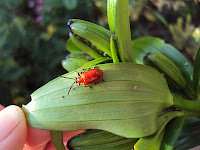This page is (constantly) under construction!
Unidentified hanging pupa found in compost bin, mid-March (on upturned bin lid). Approx 3-4mm.
Unidentified eggs found in compost bin, late March.
Unidentified cocoon found in soil, early March. Some kind of fly? Approx 4-5mm.
Turnip moth larvae, I'm pretty sure. A nasty cutworm. Found in compost bin!
Lesser Yellow Underwing moth larva - a very common and destructive cutworm.
Lesser Yellow Underwing moth larva
Lesser Yellow Underwing moth larva
Seven-spotted ladybirds
Sciarid fly (fungus gnat) larva. From those annoying little black flies that live in your houseplant pots. Usually not a problem, but this little larva destroyed a whole tray of pepper seedlings as they germinated.
Unidentified. Found in asparagus bed, late March. Approx 25-30mm. Unusually hard body with 18-19 segments.
As above.
Devil's Coach Horse larva. The Devil's Coach Horse is a generally beneficial ground beetle that eats grubs and worms in the soil.
Devil's Coach Horse larva
Unidentified. Found among grass roots, late March. Approx 10mm.
As above.
Unidentified larva, found in strawberry bed, mid-March
 As above
As aboveRed Lily beetle
Squash bug?
 Red fox
Red fox Cabbage moth (Mamestra Brassicae) caterpillar. Bad news! Pick off by hand, or spray with water and dust with flour to block their breathing holes.
Snake spotted millipedes. Feed on organic matter. They don't cause plant damage themselves, but sometimes move in on slug damage.
Bee

Bee
Small cabbage white (Pieris Rapae) caterpillar. Bad news! Pick off by hand, or spray with water and dust with flour to block their breathing holes.
Caterpillar, Arctiidae family, possibly Ruby Tiger moth. Found mid-March.

Common newt
Common newt
Red velvet mite. A garden friend, despite its alarming appearance.

Soldier beetle
Soldier beetle
Asparagus beetle. Eats asparagus and lays eggs on it. Larvae are even more destructive. Reduce numbers by growing petunias, tomatoes, basil and parsley beneath/beside asparagus, and pick any beetles or larvae off by hand.

Seven-spotted ladybird. One of a gardener's greatest friends! Eats aphids, and its larvae eat even more.
Seven-spotted ladybird
Tortoiseshell butterfly
Tortoiseshell butterfly
Cinnabar moth
Mint moth. Eats mint, but rarely does significant damage. Very pretty!
Shield bug eggs
Ladybird eggs
House spider
House spider
 Mealy cabbage aphids
Mealy cabbage aphidsBlackfly (aphids)

Whitefly and eggs on underside of broccoli leaf
Damselfly nymph
Damselfly, newly emerged
Damselfly nymph skins
Pond snail
Tadpoles
Pond snail
Pond snail eggs
Pond skater
Common garden snail
Common frog, baby
Meadow grasshopper, purple
Meadow grasshopper, purple
Harlequin ladybird. An invasive species, outcompeting our natives, but still a useful aphid-muncher. Useful info on identifying ladybirds here and here.
Bean weevils (dead), hatched out in stores - doh! To avoid this, freeze beans after drying to kill any eggs.
Grey squirrel
Common frog
Brown-lipped snail, multi-striped form
Whitefly eggs on underside of kale leaf
Mottled Arum aphid

Mottled Arum aphid and young
Unidentified weevil (not vine weevil)
Common garden snail
Sciarid fly (fungus gnat) - commonly lives in houseplant soil.
Hawthorn shield bug
Unidentified cocoon found on rosemary plant, late March. 2-3mm.
Red and black froghopper
Moth larvae, probably a Drinker. Harmless.
Unidentified fly
Six spot burnet moth
White legged snake millipede
Arion Ater slug (black slug), brown form
Large cabbage white (Pieris Brassicae) caterpillar
Large cabbage white (Pieris Brassicae) caterpillar
Earth-boring dung beetle
Meadow grasshopper
Garden spider
Peacock butterfly
Asparagus beetle
Gatekeeper butterfly
Unidentified hoverfly
Unidentified hoverfly
Unidentified hoverfly
Tortoiseshell butterfly
Frogspawn
Large cabbage white (Pieris Brassicae) caterpillar on nasturtium leaf. Nasturtiums can be effective 'bait crops' to tempt these destructive pests away from brassicas.
Wolf spider carrying egg sac
Tortoiseshell butterfly
Unidentified moth larvae, probably Geometrid family
Blackfly (black bean aphid)
Wasp nest with larvae
Common groundhopper























































































No comments:
Post a Comment